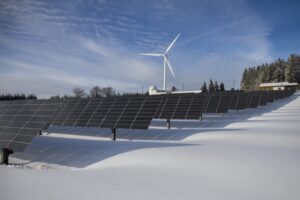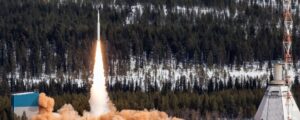- The decarbonisation of energy matrices is proving to be increasingly important as climate change advances;
- Small Scale Modular Reactors are already being implemented in some countries as a way to reduce their energy vulnerability;
- Increased use of nuclear energy will change interstate relations and international energy trade.
It is evident that the world’s population is increasingly dependent on electricity, and that energy demand is constantly increasing as transport, homes and industry are increasingly electrified.
Although electricity is clean at the point of use, its generation currently produces more than 40% of all energy-related carbon emissions when its sources come from fossil fuels such as oil, gas and coal.
Therefore, the decarbonization of electricity production is necessary and fundamental for any climate change mitigation strategy to present impactful results. In this complex environment, traditional nuclear power has proven to be a catalyst for sustainable energy transitions. However, the new Small Scale Modular Reactors may make nuclear power even more attractive as a “clean” energy source.

What are Small Scale Modular Reactors (SMRs)?
Small-Scale Modular Reactors are advanced nuclear fission reactors that have approximately one-third the generation capacity of traditional nuclear reactors. They tend to be more attractive because they are faster and cheaper to build than traditional plants.
A traditional nuclear reactor is a device used in power plants to control the nuclear fission reaction. This reaction occurs in an uncontrolled manner in the case of atomic bomb explosions, for example, but reactors have mechanisms that prevent this action, causing the reaction to be controlled and reused to generate electricity.
In this way, nuclear energy is generated, which supplies 10% of the electricity in the world, reducing carbon emissions – present on a large scale in the use of fossil fuels – and collaborating in the fight against climate change and global warming.
With the SMRs, it is expected that more countries will start using nuclear energy to “clean up” their energy matrices, and countries that already use nuclear energy will increase their use even more.
Which countries and projects are most advanced in the development and implementation of Small Scale Modular Reactors (SMRs)?
With the Russian invasion of Ukraine and Vladimir Putin’s constant threats to Europe, we could see a rush for alternative energy sources to reduce dependence on gas imported from Moscow.
Another reason is simply to vary the country’s energy matrices to achieve energy sovereignty, reducing dependence on a single source or on other nations.
As one of the options is smaller and easier to build nuclear power plants, we can already find countries that use this type of energy and many projects to be implemented. Some of them are:
- Small modulated reactors:
- China – China Huaneng, HTR-PM project, in operation;
- Russia – OKBM Afrikantov, KLT-40S Akademik Lomonosov project, in operation;
- China – Nuclear Corporation of China, ACP100 Linglong One project under construction;
- China – Nuclear Corporation of China, TMSR-LF1 project, under construction;
- Russia – Atomenergoprom, BREST-OD-300 project, under construction;
- Argentina – CNEA, CAREM project, under construction.
There are other ongoing projects, however, these are the most relevant so far.
What are the pros and cons of Small Nuclear Reactors?
Like any energy source, SMRs also have advantages and disadvantages that derive from their use.
The most relevant advantages are:
- the use of uranium as an energy source, present in abundance in nature;
- SMRs are faster and cheaper to build than traditional plants;
- the non-emission of polluting gases into the atmosphere;
- The demand for plant installation areas is small and can be moved away from large centers;
- the small amount of nuclear waste produced;
- high productivity and ability to produce without interruptions.
However, despite nuclear power being low polluting, there are some disadvantages, such as:
- despite the abundance of uranium in nature, the amount is finite, which limits nuclear energy to a non-renewable source of electricity generation;
- the heating of water in natural reservoirs, such as the sea and rivers, due to the disposal of water used in the energy generation process;
- the possible environmental and human health risks if the disposal of atomic waste is discarded in an irregular manner;
- although small, the risks of nuclear accidents.
That said, it is possible to observe that despite the benefits of using SMRs, currently the main obstacle and disadvantage to their commercial use is the licensing of new projects.
However, another advantage of reactors is that despite the initial difficulty in licensing the first unit of a given project, licensing subsequent units is generally much simpler, as all units operate in the same way.
What are the climatic consequences and geopolitics of the large-scale implementation of Small-Scale Modular Nuclear Reactors around the world?
To mitigate the impacts of climate change on the planet, society needs to quickly reduce its dependence on fossil fuels, which are the main emitters of greenhouse gases.
Nuclear energy is low-carbon and can be deployed on a large scale in an accelerated timeframe, and can provide the planet with more affordable, clean, and safe electricity.
As nuclear power is reliable and can be deployed on a large scale, it can directly replace the fossil fuel power plant, avoiding the emission of fossil fuels for electricity generation. Using nuclear energy today avoids emissions roughly equivalent to removing one-third of all cars from the world’s roads.
SMRs also reduce the need for fuel. Plants composed of SMRs may require less frequent uranium replenishment, every 3 to 7 years, compared to between 1 and 2 years for conventional plants. Some SMRs can even be designed to operate for 30 years without refueling.
In the field of geopolitics, the increase in the variety of energy matrices can cause a change in the relations between energy importing and exporting countries.
With the energy transition being conducted with the greater use of nuclear energy, the countries most negatively affected are the major producers and exporters of fossil fuels in the world, such as Saudi Arabia, Russia, Kuwait, Iraq, among others respectively.
Not by chance, at the United Nations Conferences on Climate Change (COPs), we can find a large number of oil lobbyists from these same countries trying to ensure that the new climate policies do not affect the attractiveness and profitability of the oil industry.
However, countries like the US already have nuclear technology, so a transition would not be as economically impactful for them as it would be for Saudi Arabia, which still does not have nuclear power plants in operation until this moment, for example.
On the other hand, countries that invest in technology capable of producing plants based on SMRs will benefit from the reduction of energy dependence on other countries, generating more autonomy and eventually achieving their energy sovereignty, in addition to lowering the cost of electricity for their population.
Finally, in addition to the benefit for energy-vulnerable countries that may adopt SMRs, and the environmental benefits of this adoption, there is also a great movement on the geopolitical chessboard due to the consequences that this will lead to the international import market and export of energy, whether clean or fossil fuels.








Be First to Comment